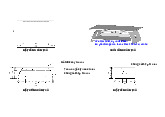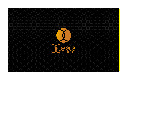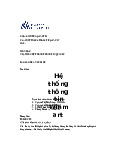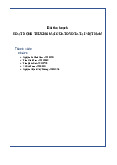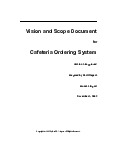







Preview text:
COURSE OUTLINE Course ID Course title Credits Warehouse & Inventory Management (FIATA) LG205DE01 03
Quản trị Nhà Kho & Tồn Kho (FIATA)
(Applied to Semester: 22.1A, Academic year:2022-2023,
Decision No……./QĐ-ĐHHS dated ……) A. Course Specifications: Periods Periods in classroom Self- Total Lecture/ Lecture Lab periods* Seminar Activity study room room Fieldwork periods (1) (2) (3) (4) (5) (6) (7) 45 45 00 90 42 00 03
(1) = (2) + (3) = (5) + (6) + (7) B. Other related Subjects: Other related Course ID Course title Subjects Prerequisites: 1 GE101DV01
English for International Integration 4 (EII 4)
Requisites: Applied one of the following courses:
Principles of Logistics and Supply Chain 1. LG206DE01/DV01 Management 2. LG319DE01/DV01 Logistics Services (FIATA) Other requirements: 1. C. Course Description:
Warehouses play an important role in supply chain management and will continue to
play that role in the future. This subject provides students in-depth understanding of key
topics in inventory and inventory management including warehouse design, warehouse
management processes, inventory control, performance, and environmental impacts. D. Course Objectives: No. Course Objectives O1.
Describing basic concepts and memorizing functions and roles related to
Warehouse and Inventory Management.
Associating the fundamentals to locate, design, and layout the warehouse
organization. Recognizing the importance of the various materials handling O2.
equipment (MHE) and warehouse management system (WMS) in operating effectively the warehouse.
Applying basic formulae to calculating inventory quantities. Employing
different order quantity models to control the company’s stock and manage well O3. the inventory total cost.
Strengthening integrative management analytical, problem-solving skills; and O4.
creating teamwork ability among the organization. E. Course Learning Outcomes: No. Course Learning Outcomes PLOs O1. CLO1.1
Define major functions and strategic roles in the different PLO1 model warehouses. (Chap 1) CLO1.2
Understand the rights and duties of the warehouse PLO1
operators; classify types of warehouse. (Chap 1) PLO2 O2. CLO2.1
Describe the main activities in warehousing and maim PLO1
factors determining the warehouse location, relative size PLO2 and internal layout. (Chap 2) CLO2.2
Explore equipment utilized within the warehouse such as PLO2
handling and storage equipment, be familiar with tools of PLO3
Bar code, QR code, RFID, and understand the PLO8
importance of Warehouse Management System (WMS)
in the warehouse operations. (Chap 3) CLO2.3
Describe the characteristics of main documents applied PLO2 in warehousing. (Chap 3) PLO6 O3. CLO3.1
Generalize the process of the into and existing out of the PLO2
warehousing. Analyze the individual activities of the PLO3
inbound and outbound processes. (Chap 4) CLO3.2
Conduct an ABC analysis, explain and use cycle PLO2
counting. Explain and use the EOQ/POQ/Quantity PLO3
discount models for independent inventory demand, and PLO5
compute a reorder point and explain safety stock. (Chap PLO8 5, Chap 6 & Chap 7) CLO3.3
Describe safe working practices and fire prevention PLO2
methodology. Understand health and safety and the PLO3
continuing pressure on companies to reduce
the effects of logistics operations on the environment. (Chap 8) O4. CLO4.1
Participate in teamwork and have the ability to recognize PLO5 No. Course Learning Outcomes PLOs
and solve problems. Follow up the rules of the course PLO7 and the group. F. Instructional Modes:
Loại hình phòng Số tiết 1 Lecture room 42 2 Fiedtrip 03 Total: 45 Requirements:
+ Language in teaching-learning: English &Vietnamese
+ Requirements for the students when taking the course:
- Students are expected to read required materials, search information on the internet or other sources before class.
- Students attend classes to capture key concepts of each chapter and they are likely to
work in group for discussion or group presentation on a specific topic. + How to organize: Modes of Maximum No Short description Periods number of instruction students 1 Traditional
- Lecturers deliver basic issues, 30 30 class (lecture) principles, new concepts, give
examples, tell stories. Students are required to discuss and brainstorm ideas related to practical issues.
- The class will combine lecture
and discussion focused on critical
thinking regarding weekly topics. 2 Group From week 3 , each students 9 3 - 5 students Presentation
group will take a presentation for group
the assigned related topic before
the lecturer conducts the weekly chapter. 3 Quiz & Test Lecturer flexibly provides 3 Individual quizzes from week 3 regarding
weekly topics, and conducts one mid-term test in week 8 or 9. 4 Field trip Three hours study tour will be 3 30
conducted from week 10 to visit
vary types of warehouse (such as DC, public/ private/ CFS warehouses, …).
G. Textbooks and teaching aids:
1. Required Textbooks and Materials: …
[1] Gwynne Richards. 2018. Warehouse Management_A complete guide to
improving efficiency and minimizing cost in the modern warehouse, 3rd edition. Kogan Page. [2] FIATA Manual.
2. Suggested Course Materials: …
[3] Jay Heizer, Render Barry and Munson Chuck. 2020. Operation Management:
Sustainability and SCM, 13th edition. Pearson.
[4] Teo Kee Boon. 2014. The Practitioners’ Definitive Guide: Process-Driven
Warehousing Operations. Singapore Logistics Association.
3. Teaching aids: (Not required)
H. Assessment Methods (Requirements for Completion of the Course):
1. Description of learning outcomes assessment
Learning outcomes can be assessed via four methods: 1.1 Group presentation:
Each group from 3 to 5 students will select randomly or be assigned based on the
weekly topics to prepare and deliver their presentation according to the lecturer’s flexible
coordination. It likely happens at beginning of each class from week 3. This activity is
counted by a 15% total of grades. 1.2 Quizzes/ Exercises:
Lecturer flexibly provides quizzes from week 3 to week 15. This activity result will
be accumulated during the course and counted by 5% total of grades. The lecturer can give
bonus marks to those students who actively contribute to the lecture or fully complete the course’s exercises if any. 1.3 Mid-term test:
This activity will be held in week 8 or week 9. This test is designed in individual
quiz form and counted by a 20% total of grades. 1.4 Final test:
This course requires a closed-book final exam. The final test is structured in two
parts, including (1) multiple-choice questions and (2) case study. This activity result will be
counted by a 60% total of grades.
2. Summary of learning outcomes assessment * For main or extra semester: Components Duration Assessment Forms Percentage Schedule CLOs Mini -Test 1 30- 45 - Group 20% Week 10 CLO2.1 minutes presentation & CLO2.2 per group discussion in class, and/or CLO3.1 and CLO3.2 CLO3.3 15 - 20 - Quizzes randomly Week 3 - 15 CLO4.1 minutes during class hours Mid-term 60 minutes - In-class Quiz Week 8 or CLO1.1 20% Test Week 9 CLO1.2 CLO2.1 CLO2.2 CLO3.1 Final Test 90 minutes - Closed-book CLO1.1 60% Exam: Multiple To be CLO1.2 choice questions announced CLO2.1 and Case study CLO2.2 CLO3.1 CLO3.2 CLO3.3 Total 100% I. Academic Integrity
Academic integrity is a fundamental value that affects the quality of teaching, learning,
and research at a university. To ensure the maintenance of academic integrity at Hoa Sen
University, students are required to:
1. Work independently on individual assignments:
Collaborating on individual assignments is considered cheating. 2. Avoid plagiarism
Plagiarism is an act of fraud that involves the use of ideas or words of another person
without proper attribution. Students will be accused of plagiarism if they: i.
Copy in their work one or more sentences from another person without proper citation. ii.
Rephraser, paraphrase, or translate another person’s ideas or words without proper attribution. iii.
Reuse their own assignments, in whole or in part, and submit them for another class.
3. Work responsibly within a working group
In cooperative group assignments, all students are required to stay on task and
contribute equally to the projects. Group reports should clearly state the contribution of each group member.
Any acts of academic dishonesty will result in a grade of zero for the task at hand
and/or immediate failure of the course, depending on the seriousness of the fraud. Please consult
Student Academic Integrity Policy at https://thuvien.hoasen.edu.vn/gioi-
thieu/chinh-sach-van-ban-9.html. To ensure the maintenance of academic integrity, the
university asks that students report cases of academic dishonesty to the teacher and/or the
Dean. The names of those students will be kept anonymous. J. Teaching Staff: Email, Phone number, Office No. Professor’s name Position Office location hours Pham Le Dung, To be 1 dung.phamle@hoasen.edu.vn Lecturer MIB informed Chau Thi Kieu
phuong.chauthikieu@hoasen.edu.vn To be 2 Lecturer Phuong, MBA informed Nguyen Phuong
lien.nguyenthiphuong@hoasen.edu. To be 3 Lecturer Lien, PhD. vn informed Tran Thi Truc Lan, To be 4 lan.tranthitruc@hoasen.edu.vn Lecturer MBA informed
K. Outline of Topics to be covered (Learning Schedule):
* For main semester or extra semester topics: Week/ Topics Homework Day References CLOs /Assignment Meeting 1/1 Chapter 1: Overall - Textbook (1)- - Reading the CLO1.1 warehouse management & Chap 1 book’s CLO1.2 operations: - Textbook (2)- chapter. - The rule of the warehouse Chap 8 & Chap - Rights and duties of the 9_FIATA Manual. warehouse operator and the customer - Types of warehouse operation - Specialized warehousing 2/2 Chapter 2: Planning, - Textbook (1)- - Reading the CLO2.1 designing and organizing the Chap 1 & Chap 9 book’s warehouse: - Textbook (2)- chapter. - Construction, layout and Chap 11_FIATA - Quiz (1) safety Manual. . Choice of location . Relative size . Internal layout . Warehouse layout examples . Finding additional space 3/3 Chapter 3: Operating the - Textbook (1)- - Reading the CLO2.1 warehouse system: Chap 10 & Chap 8 book’s CLO2.2 - Publish policy management - Textbook (2)- chapter. CLO2.3 CLO4.1 Week/ Topics Homework Day References CLOs /Assignment Meeting about the warehouse Chap 10_FIATA - Storage and materials Manual. handling equipment - Knowledge about products Bar codes - Warehouse documents, and Information technology for warehouses - Warehouse Management Systems 4/4 Chapter 4: Warehousing - Textbook (1)- - Reading the CLO3.1 management effectively: Chap 3 to Chap 6 book’s CLO4.1 - Warehouse processes: chapter. . Receiving & Put-away . Order-picking . Replenishment to Dispatch . Shipping 5/5 Chapter 4: Warehousing - Textbook (1)- - Reading the CLO3.1 management effectively: Chap 7 book’s CLO4.1 - Warehouse processes (cont): chapter. . Replenishment to Dispatch 6/6 Chapter 5: Merchandise - Textbook (1)- - Reading the CLO3.2 preservation – Warehouse Chap 7 book’s CLO4.1 inventory: - Textbook (4)- chapter. - Stock-taking Chap 11 & Chap - Inventory accuracy 12 - ABC analysis - Cycle-counting 7/7 Chapter 6: Economic - Textbook (1)- - Reading the CLO3.2 effectiveness on warehousing Chap 12 book’s CLO4.1 management (cont.): - Textbook (2)- chapter. - Warehouse costs Chap 12 & - Debit of warehouse charges/ 13_FIATA Rent Manual. 8/8 Mid-term Test (in the Quiz (2) classroom) 9/9 Chapter 6: Economic - Textbook (1)- CLO3.2 effectiveness on warehousing Chap 12 CLO4.1 management (cont.): - Textbook (2)- - Debit of warehouse charges/ Chap 12 & Rent 13_FIATA - General Manual. Week/ Topics Homework Day References CLOs /Assignment Meeting 10/10 Group Presentation All Groups CLO2.1 will do the CLO2.2 presentation CLO3.1 in the class. CLO3.2 CLO3.3 CLO4.1 11/11 Chapter 7: Inventory - Textbook (3)- - Reading the CLO3.2 Management: Chap 12 book’s CLO4.1 - Models of the inventory chapter. management EOQ – ROP. 12/12 Chapter 7: Inventory - Textbook (3)- - Group CLO3.2 Management (cont.) Chap 12 Exercises CLO4.1 - Models of the inventory management: POQ, and Quantity Discount 13/13 Chapter 8: Risk management - Textbook (1)- - Reading the CLO3.3 in Warehouse management of Chap 15 book’s CLO4.1 the Enterprise: - Textbook (2)- chapter. . Risk assessment Chap 11_FIATA . Safe working practices Manual. . Fire safety . Slips and trips . Manual handling . Vehicles . Forklift trucks . Warehouse equipment legislation,… 14/14 Fieldwork (The process, detail CLO2.1 of warehousing management at CLO2.2 the enterprise) CLO3.1 CLO3.2 CLO3.3 15/15 Overview for Final exam. Date:28 Feb. 2022 Date: 28th Feb. 2022 Date: 28th Feb. 2022 The lecturer Program Director Dean (Signature and the full name) (Signature and the full name) (Signature and the full name) Phạm Lệ Dung Tran Thi Truc Lan Pham Thi Bich Ngoc
